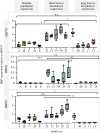Assessing the role of family level variation and heat shock gene expression in the thermal stress response of the mosquito Aedes aegypti
- PMID: 36744557
- PMCID: PMC9900713
- DOI: 10.1098/rstb.2022.0011
Assessing the role of family level variation and heat shock gene expression in the thermal stress response of the mosquito Aedes aegypti
Abstract
The geographical range of the mosquito vector for many human disease-causing viruses, Aedes aegypti, is expanding, in part owing to changing climate. The capacity of this species to adapt to thermal stress will affect its future distributions. It is unclear how much heritable genetic variation may affect the upper thermal limits of mosquito populations over the long term. Nor are the genetic pathways that confer thermal tolerance fully understood. In the short term, cells induce a plastic, protective response known as 'heat shock'. Using a physiological 'knockdown' assay, we investigated mosquito thermal tolerance to characterize the genetic architecture of the trait. While families representing the extreme ends of the distribution for knockdown time differed from one another, the trait exhibited low but non-zero broad-sense heritability. We then explored whether families representing thermal performance extremes differed in their heat shock response by measuring gene expression of heat shock protein-encoding genes Hsp26, Hsp83 and Hsp70. Contrary to prediction, the families with higher thermal tolerance demonstrated less Hsp expression. This pattern may indicate that other mechanisms of heat tolerance, rather than heat shock, may underpin the stress response, and the costly production of HSPs may instead signal poor adaptation. This article is part of the theme issue 'Infectious disease ecology and evolution in a changing world'.
Keywords: adaptation; climate warming; heat shock; heritability; thermal tolerance.
Figures



Similar articles
-
Heat Shock Proteins expression in malaria and dengue vector.Int J Biometeorol. 2025 Jan;69(1):225-232. doi: 10.1007/s00484-024-02806-2. Epub 2024 Nov 11. Int J Biometeorol. 2025. PMID: 39527249
-
Analysis of the transcription of genes encoding heat shock proteins (hsp) in Aedes aegypti Linnaeus, 1762 (Diptera: Culicidae), maintained under climatic conditions provided by the IPCC (Intergovernmental Panel On Climate Change) for the year 2100.Infect Genet Evol. 2020 Dec;86:104626. doi: 10.1016/j.meegid.2020.104626. Epub 2020 Nov 7. Infect Genet Evol. 2020. PMID: 33166684
-
Expression of heat shock proteins (HSPs) in Aedes aegypti (L) and Aedes albopictus (Skuse) (Diptera: Culicidae) larvae in response to thermal stress.Acta Trop. 2017 Mar;167:121-127. doi: 10.1016/j.actatropica.2016.12.017. Epub 2016 Dec 24. Acta Trop. 2017. PMID: 28024869
-
Thermotolerance and the heat shock proteins.Symp Soc Exp Biol. 1987;41:269-83. Symp Soc Exp Biol. 1987. PMID: 3332487 Review.
-
Review: The role of heat shock proteins in chicken: Insights into stress adaptation and health.Res Vet Sci. 2023 Dec;165:105057. doi: 10.1016/j.rvsc.2023.105057. Epub 2023 Oct 16. Res Vet Sci. 2023. PMID: 37864906 Review.
Cited by
-
Genome-wide analysis and characterization of HSP gene families (HSP20, HSP40, HSP60, HSP70, HSP90) in the yellow fever mosquito (Aedes aegypti) (Diptera: Culicidae).J Insect Sci. 2023 Nov 1;23(6):27. doi: 10.1093/jisesa/iead114. J Insect Sci. 2023. PMID: 38102758 Free PMC article.
-
The thermal stress response of Aedes aegypti and Aedes albopictus when exposed to rapid temperature changes.Parasit Vectors. 2025 Jul 26;18(1):300. doi: 10.1186/s13071-025-06951-4. Parasit Vectors. 2025. PMID: 40713850 Free PMC article.
-
Infectious disease ecology and evolution in a changing world.Philos Trans R Soc Lond B Biol Sci. 2023 Mar 27;378(1873):20220002. doi: 10.1098/rstb.2022.0002. Epub 2023 Feb 6. Philos Trans R Soc Lond B Biol Sci. 2023. PMID: 36744560 Free PMC article. No abstract available.
-
Mosquito thermal tolerance is remarkably constrained across a large climatic range.Proc Biol Sci. 2024 Jan 31;291(2015):20232457. doi: 10.1098/rspb.2023.2457. Epub 2024 Jan 24. Proc Biol Sci. 2024. PMID: 38264779 Free PMC article.
-
Elevated developmental temperatures below the lethal limit reduce Aedes aegypti fertility.J Exp Biol. 2025 Feb 1;228(3):JEB249803. doi: 10.1242/jeb.249803. Epub 2025 Feb 7. J Exp Biol. 2025. PMID: 39760305 Free PMC article.
References
MeSH terms
Substances
Associated data
LinkOut - more resources
Full Text Sources

